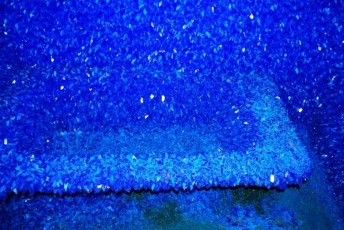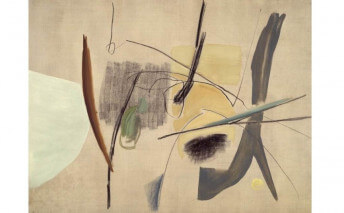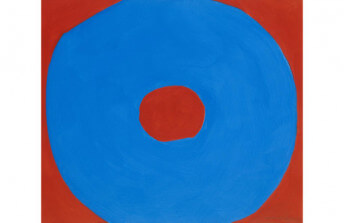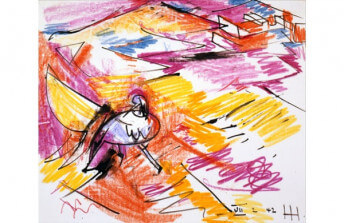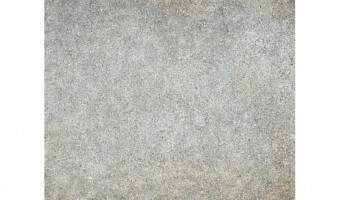How Gutai’s Kazuo Shiraga Suddenly Rose to Fame
May 17, 2017
A generation ago, the name Kazuo Shiraga would not have meant anything to most curators, academicians and art collectors in the United States. Neither would the word Gutai have gotten much of a reaction out of such people. But in the past few years, the names Kazuo Shiraga and Gutai have been getting a lot of attention in American art circles. Kazuo Shiraga died in 2008 at the age of 83. At the time of his death he had achieved an enormous amount of recognition in his homeland of Japan, as well as in Europe and other places outside of the United States. His fame originated from his status as one of the most influential members of an avant-garde art collective known as the Gutai Art Association, or the Gutai Group, which emerged in the Japanese city of Osaka in the aftermath of World War II. The founder of Gutai was an artist named Jiro Yoshihara, who understood that it was not only the physical aspects of Japan that needed reconstruction after the war, but that its culture was also in complete disarray. Yoshihara wrote a manifesto explaining that the artists of Gutai were dedicated to total originality, sworn never to imitate others, but were instead endeavoring to “create what has never been done before.” Gutai Group members hoped they could develop a new and completely authentic Japanese aesthetic position for the new age: one that encouraged individuality, and discouraged the conformist mentality that they believed had led the previous generation to become complicit in an unjust and unnecessary war.
In the opinion of many modern scholars, Kazuo Shiraga is considered the most brilliant member of Gutai. He expressed in the most direct and approachable way one of the most important aspects of the Gutai philosophy: the idea of concreteness. The word Gutai itself can be translated as concreteness, or as the process of becoming concrete. The Gutai philosophy professes that abstract notions cannot be universally understood, and can thus lead to confusion and misdirection. But by engaging directly with materiality and process, Gutai artists such as Shiraga believed the concrete principals of the world would reveal themselves in their work in undeniable and immediately understandable ways.
One of the earliest and most influential works through which Shiraga expressed his view of concreteness was a performance piece titled Challenging Mud (1955). For this piece, Shiraga stripped down to his shorts and dropped to the ground in a swampy patch of wet mud and cement. He then proceeded to wrestle with the mud, using his entire body to create the massive, wild gestures, carving marks into the ground and squishing and thrusting towers of mud upward. The result was both a performance as well as a sculptural relic that remained in the aftermath of the action.
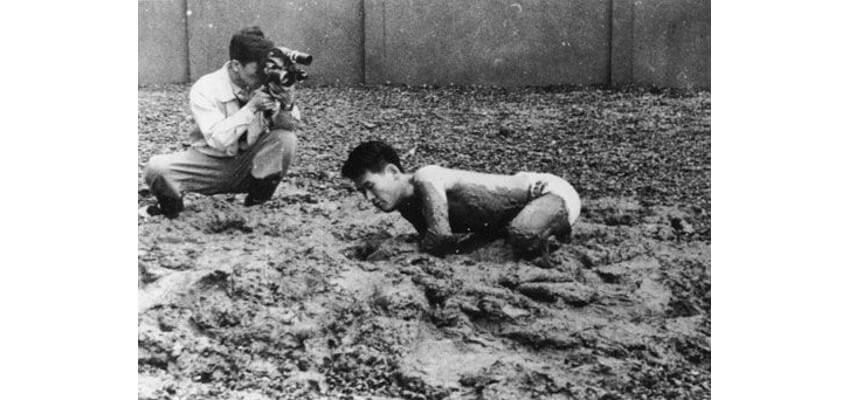 Kazuo Shiraga - Challenging Mud, 1955. © Kazuo Shiraga
Kazuo Shiraga - Challenging Mud, 1955. © Kazuo Shiraga
Prior to being invited by Jiro Yoshihara to join Gutai, Shiraga had been classically trained as a painter. But in the spirit of individuality, uniqueness and experimentation, he dramatically evolved his painting practice, adopting a technique in which he laid his canvases directly on the floor then stomped the paint onto the surface with his feet. The physical power of his motions, combined with the blood red qualities of his chosen medium, left an impression of violence, power and angst on his stomped canvases. Said Shiraga at the time about this stage of his evolution as a painter, “I want to paint as though rushing around a battlefield, exerting myself to collapse from exhaustion.”
The next development in his painterly evolution came in the 1960s, when Shiraga developed a technique that involved painting while hanging from a rope tied to the ceiling. Suspended above his canvases, he painted compositions with the various parts of his body that could make contact with the surface while he dangled and swung. This technique harnessed gravity and kinetic energy, utilizing specific concrete processes that allowed more graceful, lyrical gestures to manifest on his canvases. Along with this change in technique, Shiraga simultaneously introduced a larger range of colors into his work. The combined result signaled that he was moving beyond the power and anger of his earlier efforts, in search of something more sublime.
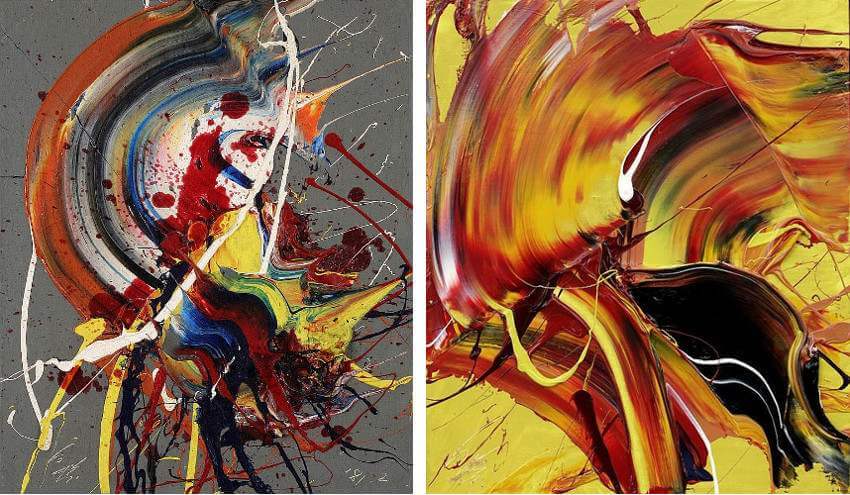 Kazuo Shiraga - Matsuri No Hi, 1981 (Left) and Sacred Flame, 1975 (Right). © Kazuo Shiraga
Kazuo Shiraga - Matsuri No Hi, 1981 (Left) and Sacred Flame, 1975 (Right). © Kazuo Shiraga
The essential qualities of Gutai as expressed by Kazuo Shiraga had something in common with global trends like Abstract Expressionism, Lyrical Abstraction, Tachisme, Happenings and the Fluxus movement. For that reason, the movement was initially misunderstood when it was first brought to the United States, in an exhibition at Martha Jackson Gallery in New York, in 1958. Critics panned the show, calling it derivative of Abstract Expressionism. Such a reading of Gutai was misinformed and ignorant, as it overlooked the experimentation, materiality, individuality and uniqueness at its core. Sadly that mischaracterization led to Gutai being virtually ignored by American institutions and collectors for decades to come.
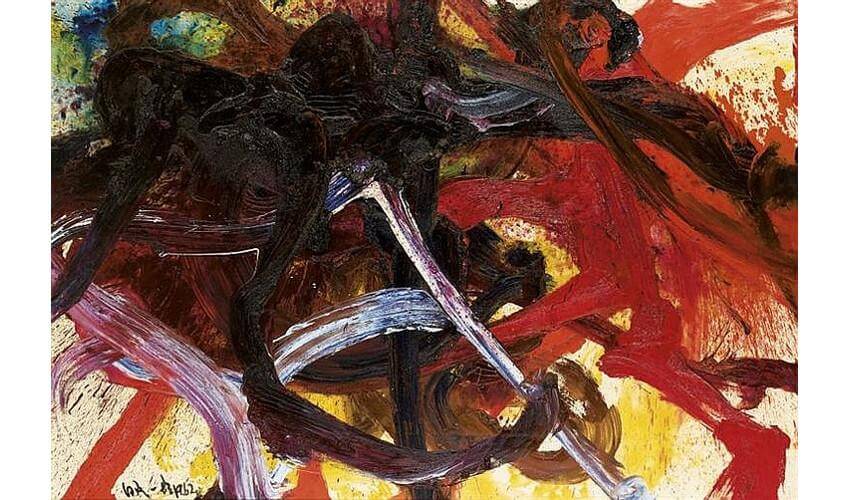 Kazuo Shiraga - Tenkosei Kaosho, 1962. © Kazuo Shiraga
Kazuo Shiraga - Tenkosei Kaosho, 1962. © Kazuo Shiraga
In fact, so unknown was Shiraga to Americans near the end of his life that in 2003 his paintings from the 1960s were still selling for less than $50,000 (US) at auction. But all of that finally changed in 2013, when the Guggenheim Museum in New York staged the comprehensive exhibition Gutai: Splendid Playground. The first major American museum exhibition of Gutai, the show contextualized the movement from a more balanced and historically accurate, global perspective. The show placed Gutai on an equal footing with the other major global art trends of the Post-War period, and also made a household name of Kazuo Shiraga. Just one year after the exhibition, one of his paintings from 1969 sold at auction at Sotheby’s for more than $5 million (US).
Since that monumental exhibition at the Guggenheim, the works of Kazuo Shiraga have appeared in more than half a dozen gallery and museum exhibitions across the United Staes. Shiraga and his Gutai cohorts are finally getting their due in America. To many casual observers it may seem like a sudden rise to fame. But in reality the rest of the world has known about his important work, and the massive influence of Gutai, for a long time.
 Kazuo Shiraga - Untitled, 1963. © Kazuo Shiraga
Kazuo Shiraga - Untitled, 1963. © Kazuo Shiraga
Featured image: Kazuo Shiraga - BB64 (detail), 1962. © Kazuo Shiraga
All images used for illustrative purposes only
By Phillip Barcio

